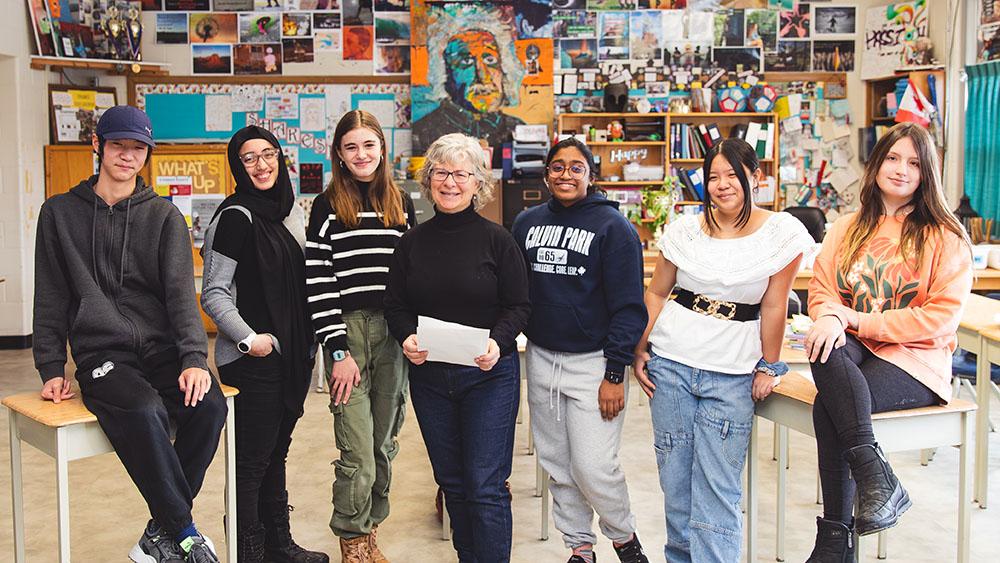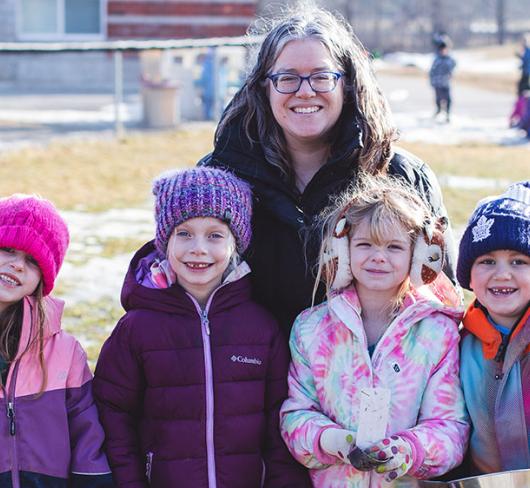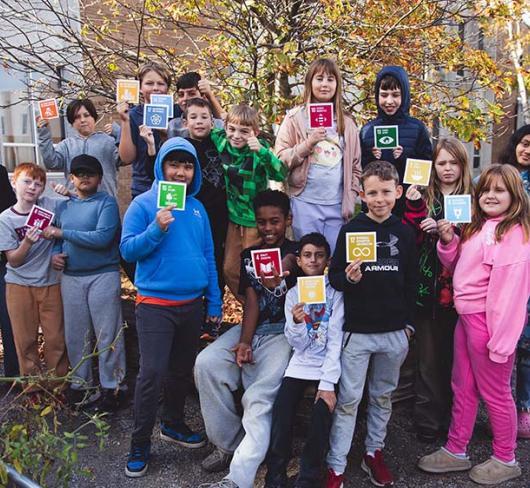
Fighting Climate Anxiety with Imagination
The climate crisis is no longer theoretical and our students are worried. I was thinking about this when I saw an email, one of many in my inbox, written by an engaged and passionate environmental activist. Bulk emails often get overlooked. This one caught my attention because I thought it might address those student fears and also allow me to foster an interrelationship between different curriculum concepts I was already teaching.
As a Grade 8 teacher, I am constantly trying to find ways to promote critical thinking, application and metacognition practices. When I read about the idea of a festival that sparked questions around sustainable solutions, promoted inquiry about environmental innovations and allowed students to extend and build on their learning in geography, I was in.
Youth Imagine the Future introduces students in grades 7 to 12 to the positive and inspiring choices that people are making around the world to create a climate resilient and more socially equitable future. The festival offers free workshops in classrooms anywhere in the eastern Ontario region covered by the Limestone District School Board, from Kingston north to Whitney. Jerreat or another presenter will bring in a slide show of ideas for technological or nature-based green solutions to environmental issues.
It can be challenging to find new ways to plant the seed of active citizenship and stewardship in students. Prior to Jerreat’s involvement in our class, we were tackling the Grade 8 geography curriculum focused on global sustainable land use. We had examined features of sustainable communities around the world (e.g., Singapore) and analyzed challenges and barriers that are components to all environmental initiatives. The Youth Imagine the Future workshop helped us deepen our discussions, demand more answers and look for ways to create change in a world that we have mistreated.
My students enjoyed learning about the small wind turbines being developed in the U.K., which are about the size and shape of a basketball and intended to be attached to a balcony to create electricity. Miyawaki urban forests, being planted across India, Europe, and here in Kingston, also caught their attention. After the slide show, Jerreat invited students to play around with designing a better future for a specific place in the world they know well, such as their home region. Jerreat had them jot down ideas they liked during the slide show, then led them through creative writing bursts.
Finally, students were encouraged to either write a fictional short story set in that better future they had designed – introducing the class to a new literary genre called “solarpunk” – or to create a piece of art to show their future.
Climate or Eco-Anxiety is a Serious, Growing Phenomenon Among Youth Across Canada
Professors at both Simon Fraser University and Lakehead University are tracking the growth of climate anxiety. Those universities are now offering group climate-anxiety counselling sessions for students. No doubt others will follow suit.
Eco-anxiety is affecting students of every age, more so after over 600 people died in the Vancouver-area heat wave of June 2021, and after constant smoke warnings were issued across Ontario from wildfires in 2023, as well as extreme storms and frequent tornado warnings. Last year, Ontario heat waves began in April and tornadoes touched down in Ottawa and Quebec in July. It was a summer of extreme climate dangers filling our news and strange yellow-grey skies overhead.
Jerreat believes that youth don’t need to read more dystopias. However, we need their imagination.
Several of my students created inspiring and well-crafted writing pieces that brought their geography learning into the literacy domain. Others used their visual arts skills to bring to life ideas of a greener future. To activate thinking, Jerreat read an excerpt from one of her published climate-fiction short stories. The components of the solarpunk genre, paired with a writing technique to share sensory details of the plot’s setting, allowed my students to create and experience a new and better future.
It was exciting to watch as students stepped out of the all-too-familiar dystopian literary context into a future that offered hope with sustainable action plans. Mental pictures were created through environmental word choices and I witnessed their mindsets shift to appreciate the value of a biological community that is dependent on one another. It was incredible to witness students starting to grapple with how to narrate their stories and how to expose the climate crisis that we are facing, showing hopeful solutions. Each submission for the festival helped to embody individual responsibility in our youth, allowing their ideas to become a part of the movement for climate action.
The Youth Imagine the Future festival was new in 2022 and experienced a few glitches with form submissions. However, many of my students completed or nearly completed a short story, under 2,000 words, and submitted them with forms filled out by guardians. Even more of my students participated in 2023. It was very helpful to have the criteria the juries would use to grade the submissions posted clearly on the website.
Throughout November, the festival’s 20-member reading jury – consisting of published writers, university professors, teachers and principals – worked through written submissions. Visual art was evaluated by a jury of 12 local artists and art teachers.
By December, the Window Art Gallery in Kingston had opened an exhibit of the art and stories for the public. The walls were full of colourful and surprising futures. Some were three-dimensional pieces. All were displayed with the title, artist’s name and a description by the artist of what their art represented. Wandering the gallery was a powerful experience.
One art piece had an old freight ship converted into a community food garden atop housing towers. This represented the end of long-distance shipping, and featured living green walls, solar panels and canvas dirigibles with propellers for wind energy. Another reimagined Spadina Avenue in Toronto with an EV train instead of cars, small urban forests and balconies of trees and food gardens. The winning art piece was a 3D rendering of some old heritage houses in Kingston redesigned into multi-family housing with rooftop and ground-level food gardens and solar panels that fold up at night like nyctinasty plants.
I had the honour of attending the festival’s culmination award ceremony both years. Each time, the art gallery was packed. Local politicians, writers, artists and environmentalists gave out 30 awards to the students. The judges had written short passages for each award that were unique to each story or artwork. Throughout the awards presentations, the excitement in the room built as each category was acknowledged and environmental issues were addressed. Our students were recognized as trail blazers in our community, igniting environmental thinking and action.
The evenings were celebrations of student voice, with expression and imagination joining the conversation about a better future. What I enjoyed most was witnessing a community of learners, professionals and educators celebrating our youth and demanding change for a better planet.
How to Use These Ideas in Your School
The climate crisis is happening and demands real climate education for our students. Youth Imagine the Future (YIF) resources can be used by any teacher or any school to bring positive, solution-based climate education into our classrooms.
At a classroom level, teachers can email YIF (youthimaginefuture@gmail.com) to invite a presenter to give a workshop in person or by Zoom. Or teachers can request the slide show and present it themselves. The slide show would then be narrated and a creative writing workshop would follow to help students really delve into imagining a better future.
YIF also has a toolkit freely available to help any group create a school-wide or board-wide festival to suit their needs. It comes with templates for everything from letters requesting donations for prizes to suggestions on a timeline and what a festival might need.
In Limestone, several teachers used the YIF workshop in different ways, incorporating the ideas of how people around the world are adapting or mitigating the effects of climate change into their own teaching.
Tracy Bridgen and Matt Gallupe, teaching at Southview Public School in Napanee, used the YIF workshop to jumpstart a literacy-geography inquiry project called “Sustainable Street.” Students were asked to imagine what it could look like to cross a street in the future, then to create a design that showed how that street would be sustainable and innovative. They had to consider how electricity would be created and how transportation might be different. As well as drawing the street from a bird’s-eye or street-level view on grid paper, students wrote and edited several paragraphs to explain their ideas.
“Students used ideas from the Youth Imagine the Future presentation and researched other sustainable options. Many included kinetic tiles and colourful solar panels made from vegetables. It all opened the door for further discussions on how to improve the way we live so that the Earth doesn’t suffer,” said Bridgen.
Other classes used the YIF workshop to begin a science/art project. Catherine Tang’s Grade 7 class attended a YIF workshop. Tang says that she wanted “an opportunity for students to research environmental innovations and imagine a better future while also giving them a chance to exercise their creativity. “We used John Spencer’s LAUNCH cycle, a student-friendly version of the design process, and students explored a range of solutions including greening cities, reducing light pollution, and active and low-carbon transportation. Some of the resulting art pieces showed two futures side by side: one in which the current path continued, and the other in which changes were made and the future was much improved.”
Kevin Wood at Central Public School in Limestone had his Grade 7/8 students redesign their school neighbourhood the year before YIF came to his class. They invited an architect in as a guest speaker, looked at problem spots and planned together. It created a lot of excitement in the class. They decided that Queen Street nearby should have an electric train and the roofs could become green and solar. All grassy areas were reimagined with community food gardens. Wood helped the students present their ideas to city council.
My own classes moved on past the festival to investigate human settlement through geographic inquiry. Our learning focused on types of land use, natural disasters, economic development and the interrelationships needed to develop sustainable communities. Students became urban planners, community designers and cartographers while producing a proposal for a developed community with a sustainable action. As teachers, we are fostering the growth of ideas, innovative solutions and plans for a better future within the citizenship education framework.
Youth Imagine the Future is an example of how we might turn our students toward considering solutions for a better future, from sponge parks in Montreal to the green roof bylaw in Toronto, from planting urban forests with Little Forests Kingston to protecting and restoring a wetland. This kind of climate work invites youth to have a voice about these critical issues in the community and focuses on real solutions being used around the world.
We need more changemakers. This festival, with its global ideas, passion for education and imperative of activating our youth to use their imaginations, was contagious. It started with an email and is now spreading optimistic ideas, snowballing through families and communities, inspiring hope.
As teachers, we are mentors, counsellors, role models and in the best sense, activists. Consider some version of positive, solution-based climate education for your students.
Dawn Williams is a member of the Limestone Teacher Local.
Resources
Youth Imagine the Future – A Festival of Stories & Art youthimaginethefuture.com youthimaginefuture@gmail.com (to request the slide show and/or workshop)
Climate Change Short Stories for Students and Teachers, by Sarah Outterside-Murphy (Morningside Centre for Teaching Social Responsibility) morningsidecenter.org/teachable-moment/ lessons/climate-change-short-stories-students-and-teachers
Rules for a Civilization, by Jerri Jerreat, from the anthology Glass and Gardens: Solarpunk Winters (World Weaver Press). Set in a classroom in Toronto in the future. When a hurricane hits, everyone has to work together worldweaverpress.com
Mad Scientists, by Jerri Jerreat, on Fairlight Books Short Stories online. A young occasional teacher in Ontario struggles to teach Grade 8 science, leading to climate activism. fairlightbooks.co.uk/short_stories/mad-scientists
The Earthshot Prize earthshotprize.org
The James Dyson Award jamesdysonaward.org
The Many Benefits of the Minuscule but Mighty Miyawaki Forests by Alanna Mitchell, Canadian Geographic. canadiangeographic.ca/articles/the-many-benefits-of-the-minuscule-but-mighty-miyawaki-forests

